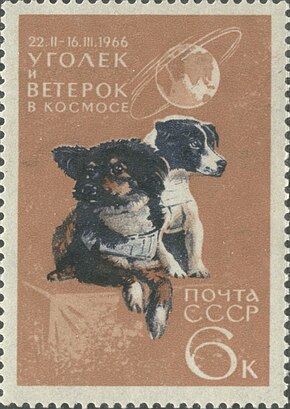Kosmos 110
 | |
| Mission type | Biosciences |
|---|---|
| Operator | OKB-1 |
| COSPAR ID | 1966-015A |
| SATCAT no. | 02070 |
| Mission duration | 22 days |
| Spacecraft properties | |
| Spacecraft | Voskhod 3KV No.5 |
| Spacecraft type | Voskhod 3KV |
| Manufacturer | OKB-1 |
| Launch mass | 5700 kg [1] |
| Start of mission | |
| Launch date | 22 February 1966, 20:09:36 GMT |
| Rocket | Voskhod 11A57 s/n R15000-06 |
| Launch site | Baikonur, Site 31/6 |
| Contractor | OKB-1 |
| End of mission | |
| Disposal | Recovered |
| Landing date | 16 March 1966, 14:09 GMT |
| Landing site | Steppes of Kazakhstan |
| Orbital parameters | |
| Reference system | Geocentric orbit [2] |
| Regime | Low Earth orbit |
| Perigee altitude | 190 km |
| Apogee altitude | 882 km |
| Inclination | 51.9° |
| Period | 95.3 minutes |
Kosmos 110 (Russian: Космос 110 meaning Kosmos 110) was a Soviet spacecraft launched on 22 February 1966 from the Baikonur Cosmodrome aboard a Voskhod rocket. It carried two dogs, Veterok and Ugolyok.
Mission
The launch of Kosmos 110 was conducted using a Voskhod 11A57 s/n R15000-06 carrier rocket, which flew from Site 31/6 at Baikonour. The launch occurred at 20:09:36 GMT on 22 February 1966. Kosmos 110 separated from its launch vehicle into a low Earth orbit with a perigee of 190 km (120 mi), an apogee of 882 km (548 mi), an inclination of 51.9°, and an orbital period of 95.3 minutes.[2]
It incorporated a re-entry body (capsule) for landing scientific instruments and test objects. It was a biological satellite that made a sustained biomedical experiment through the Van Allen radiation belts with the dogs Veterok and Ugolyok. On 16 March 1966, after 22 days in orbit around the Earth, they landed safely and were recovered by recovery forces at 14:09 GMT.[2]
This spaceflight of record-breaking duration was not surpassed by humans until Soyuz 11 in June 1971 and still stands as the longest space flight by dogs.
See also
References
- ^ "Display: Cosmos 110 1966-015A". NASA. 14 May 2020. Retrieved 16 January 2021.
 This article incorporates text from this source, which is in the public domain.
This article incorporates text from this source, which is in the public domain.
- ^ a b c "Trajectory: Cosmos 110 1966-015A". NASA. 14 May 2020. Retrieved 16 January 2021.
 This article incorporates text from this source, which is in the public domain.
This article incorporates text from this source, which is in the public domain.

